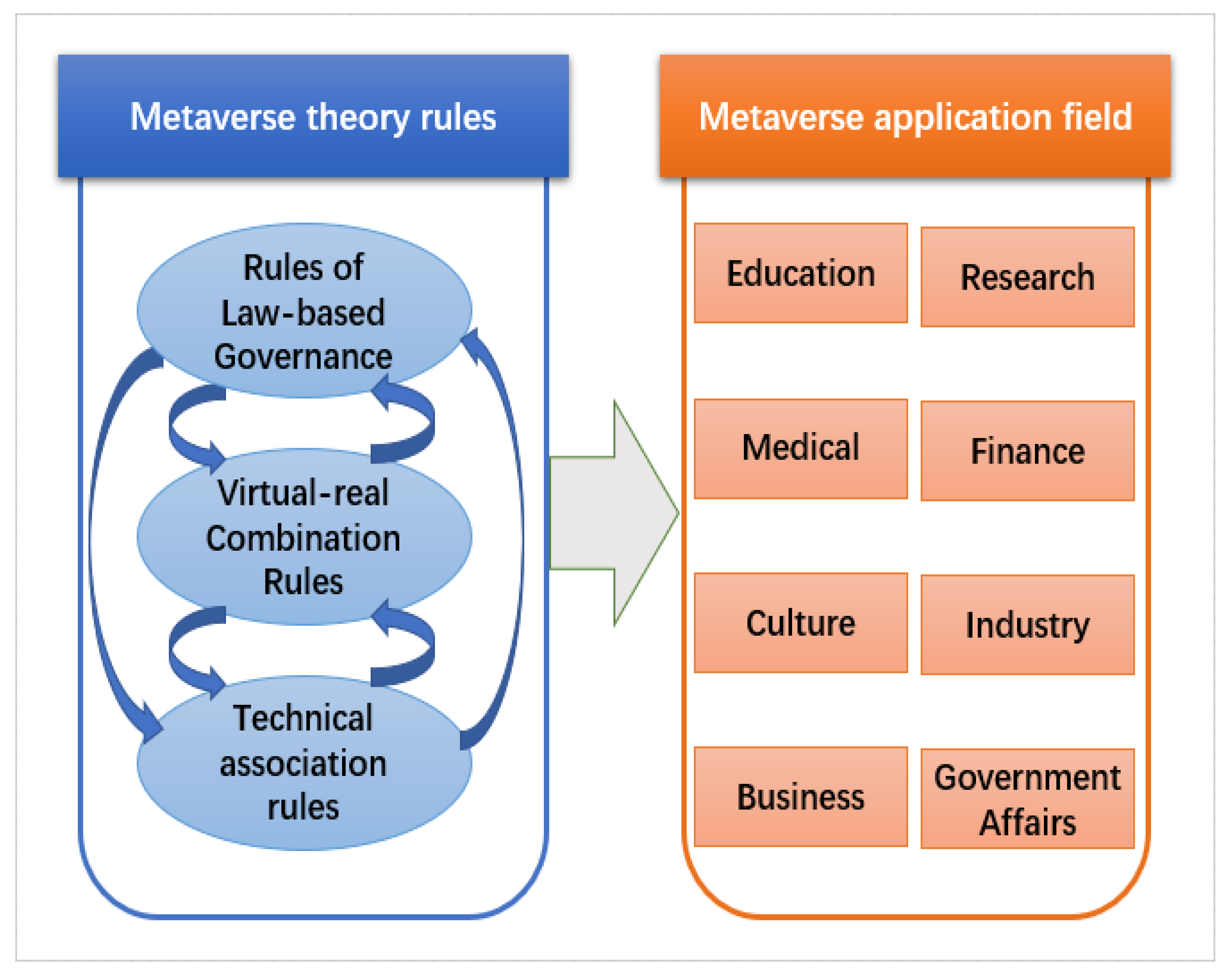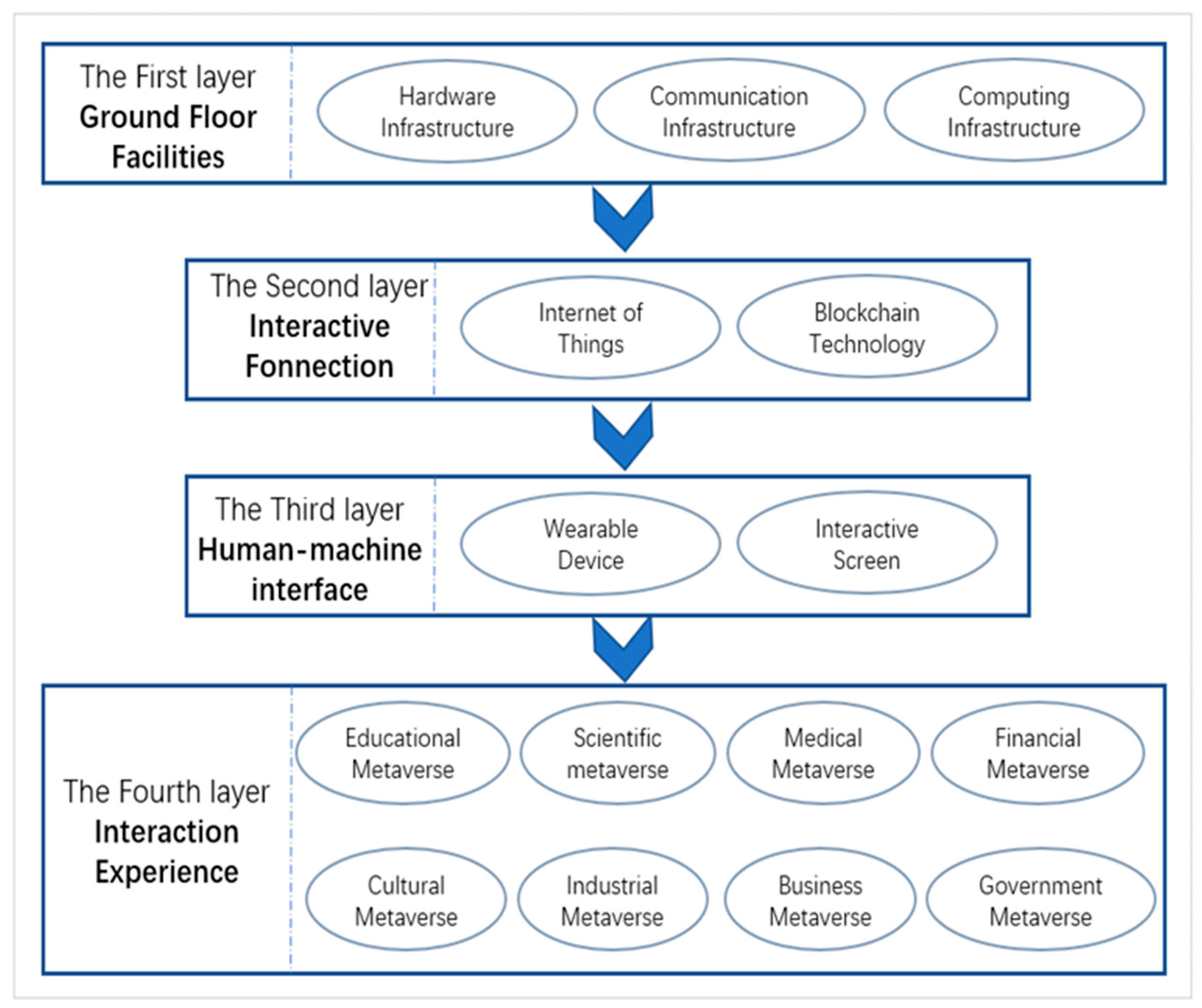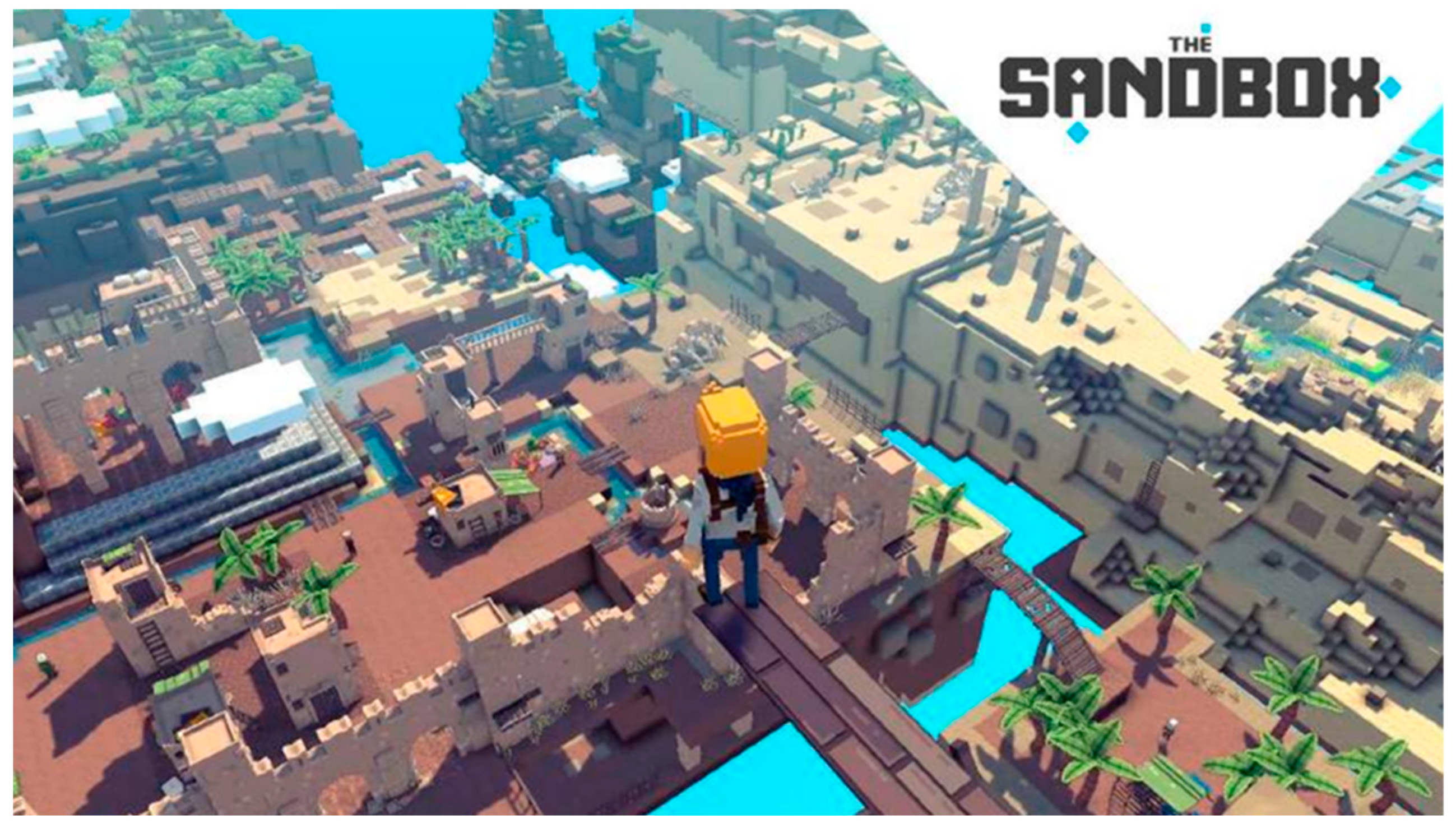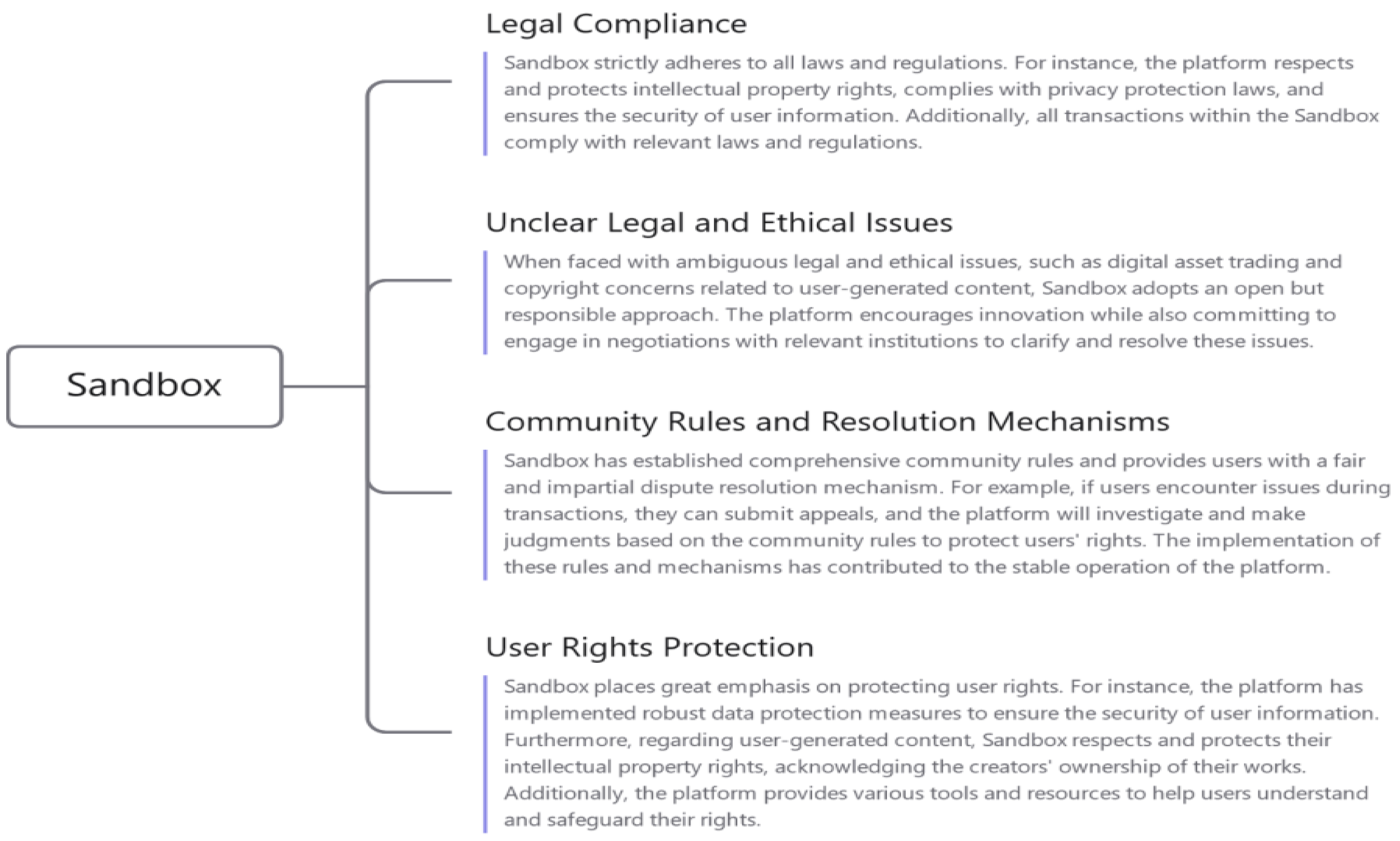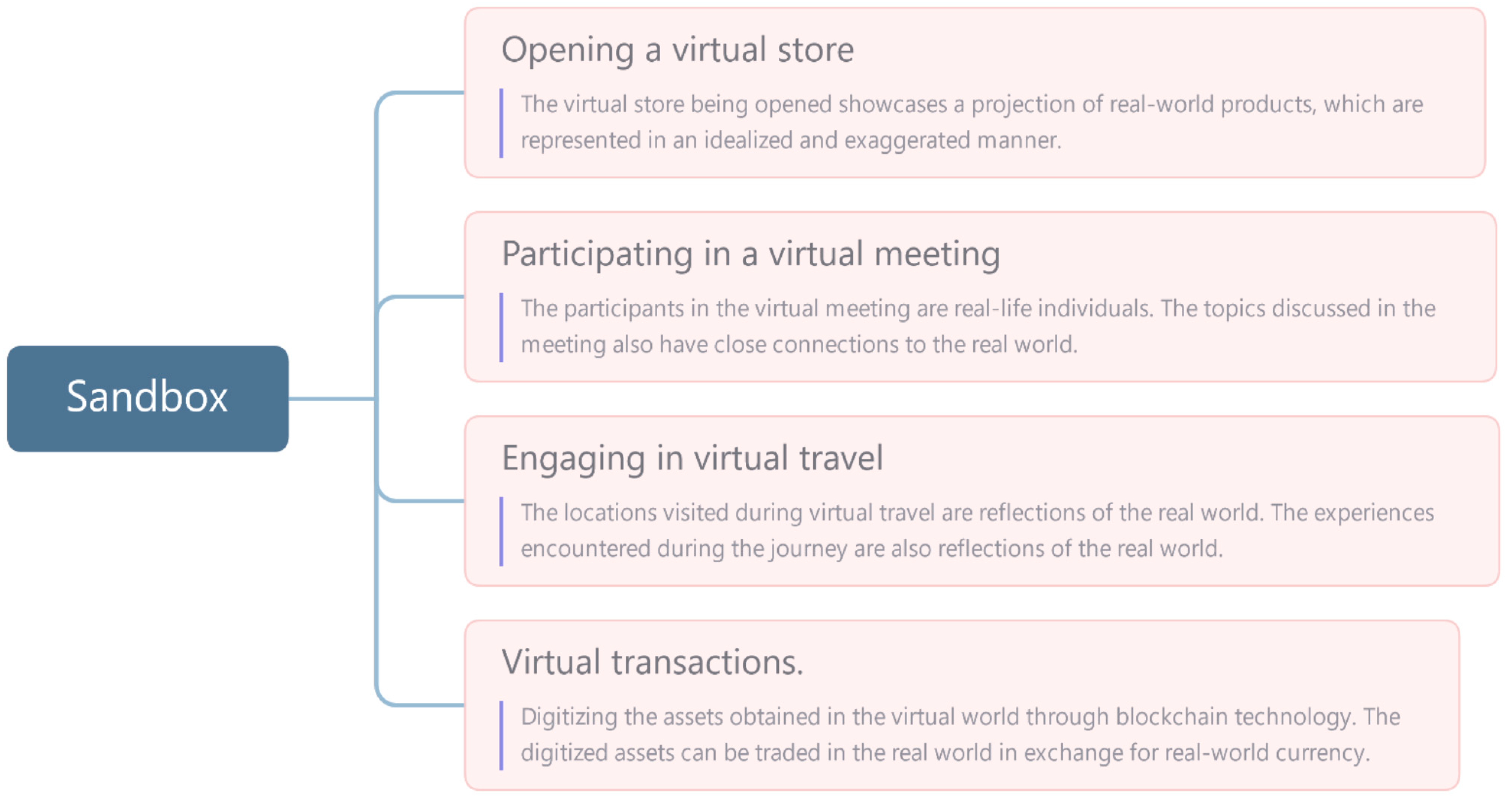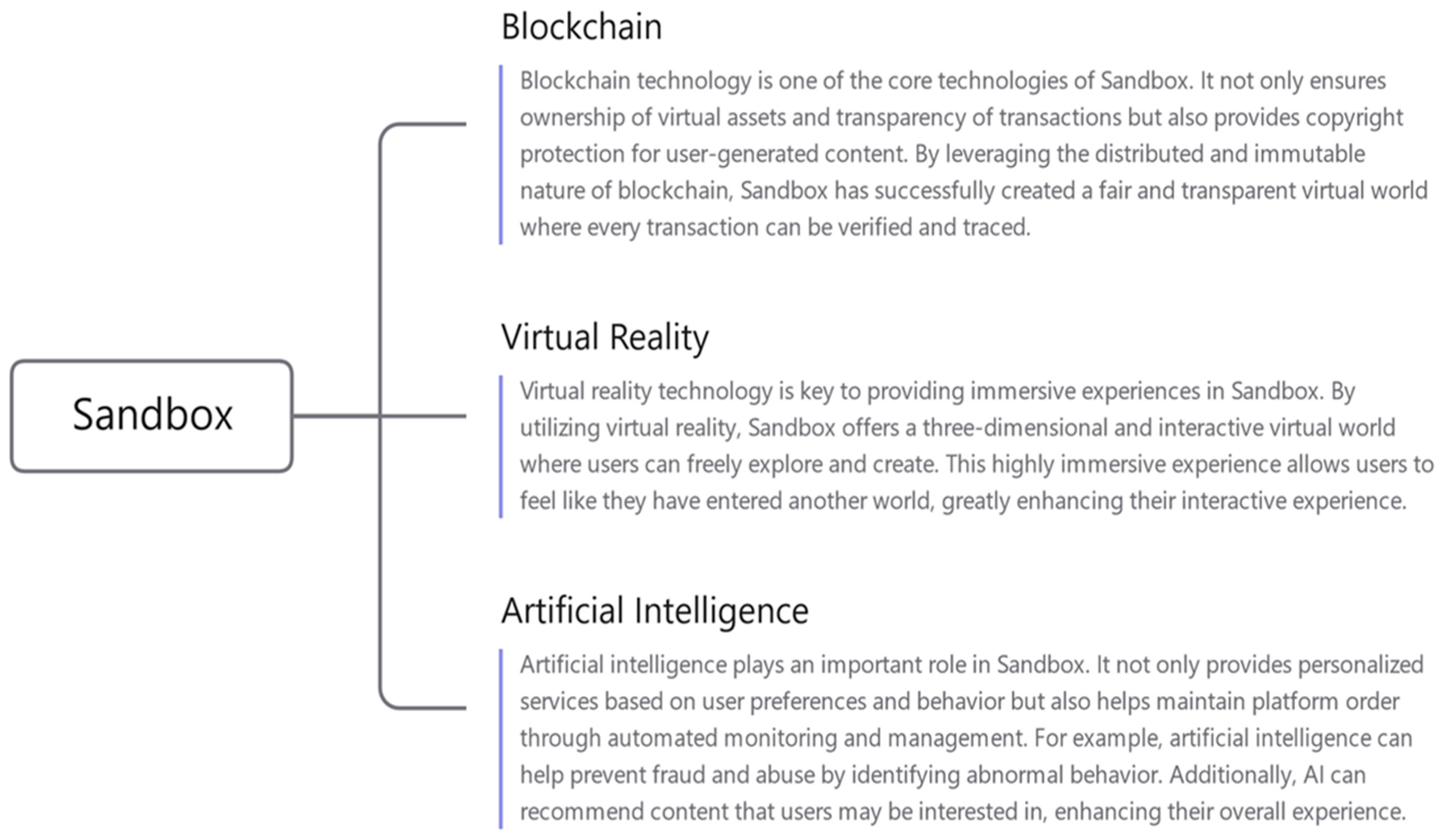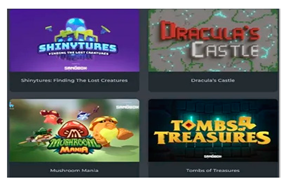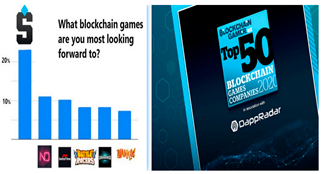1. Introduction
1.1. Background and Importance of the Topic
In the wake of advanced technologies such as virtual reality (VR), augmented reality (AR), blockchain, and artificial intelligence, the Metaverse has emerged as a prominent subject in technology [
1]. The Metaverse can be construed as a parallel universe, constituted by innumerable 3D virtual worlds; these virtual realities are an amalgamation of diverse online interactive experiences and assets. Users can engage with others through avatars, partake in various activities, and even possess and trade virtual items and land within the Metaverse [
2].
This novel form of Internet application is gradually transforming how people live and work, expanding the horizons of the digital economy and profoundly influencing the real world. Against this backdrop, the essential attributes of the Metaverse and the theoretical framework for its research have become indispensable tools for understanding and shaping this burgeoning field [
3].
The digitization of assets in the Metaverse, scenario-based applications, scope economics, industry universality, integrative innovation, and platform ecosystem hold far-reaching implications for promoting social and economic development, advancing the restructuring of industrial setups, and enhancing the quality of public life. A comprehensive and deep exploration of these characteristics is of great significance for comprehending the value of the Metaverse, optimizing its development, and propelling the sustainable and healthy evolution of industries associated with the Metaverse [
4].
Thus, a profound investigation of the critical features of the Metaverse and the establishment of a theoretical framework provide not only fresh perspectives and methods for academic research but also offer robust support and guidance for practical applications and decision-making processes. This holds substantial theoretical and functional worth. All these factors underscore the criticality and urgency of this research topic [
4].
1.2. Metaverse Concept Overview
The Metaverse is a virtual, parallel universe composed of countless digitized spaces. It comprises various online interactive experiences and digitized assets, providing new social and economic freedom of infinite possibilities. Within the Metaverse, users can interact with others through virtual avatars, participate in various activities, and even own and trade virtual goods and lands [
2].
The emergence of the Metaverse is primarily attributed to the rapid development and broad application of cutting-edge technologies such as virtual reality (VR), augmented reality (AR), artificial intelligence (AI), and blockchain. These technologies have provided technical support and possibilities for constructing the Metaverse, enabling its application in various scenarios and fields [
5].
Key features of the Metaverse mainly include asset digitization, application scenario-based, scope economics, industry universality, integrated innovation, and the platform ecosystem. Asset digitization allows everything in the Metaverse to be digitized and has unique ownership [
6]. Application scenario-based enables the Metaverse to be applied to various scenarios, such as entertainment, education, shopping, etc. [
7]. Scope economics implies that the Metaverse can provide users with infinite possibilities and opportunities [
8]. Industry universality allows the Metaverse to be applied across various industries. Integrated innovation is reflected in the Metaverse’s ability to merge multiple technologies and innovations, pushing the development of the Metaverse [
9]. The platform ecosystem feature manifests as the Metaverse’s ability to form a global, shared, decentralized digital ecosystem [
10].
To better understand and research the Metaverse, this study proposes a theoretical framework for Metaverse research, including rules of governance by law, rules of blending virtual with reality, and rules of technological associations. This theoretical framework will help us fully understand the characteristics of the Metaverse, guide the development of the Metaverse, and provide academic support for related decision making.
1.3. Brief Layout of the Paper
The structure and layout of this research paper are well ordered, allowing readers to understand better the theoretical framework of the Metaverse and its essential characteristics. The organization of the article is as follows:
We introduce in detail the key characteristics of the Metaverse, including asset digitization, application scenario-based, scope economics, industry universality, integrated innovation, and the platform ecosystem. These characteristics provide a foundation for understanding the value and potential of the Metaverse. We construct a theoretical framework for Metaverse research, mainly including rules of governance by law, rules of blending virtual with reality, and rules of technological associations. This part provides powerful tools and directions for further Metaverse research. We utilize empirical research methods to conduct a case study of the Metaverse to verify the applicability and explanatory power of the theoretical framework proposed in this study. Finally, in the conclusion section, we summarize this research and provide a forward-looking perspective on the future development of the Metaverse.
The entire paper aims to deepen the understanding of the Metaverse while simultaneously providing strong support for the formulation and implementation of related policies through the analysis of the critical characteristics of the Metaverse and the construction of the theoretical framework.
1.4. Research Objectives
This research aims to establish a comprehensive theoretical framework for Metaverse research and delve deep into its essential characteristics. Specifically, the primary goals of this study are as follows:
- (1)
Unveil and interpret the key features of the Metaverse, including asset digitization, application scenario-based, scope economics, industry universality, integrated innovation, and the platform ecosystem. This will provide a scientific theoretical foundation for understanding and applying the Metaverse;
- (2)
Construct a theoretical framework for Metaverse research, utilizing rules of governance by law, rules of blending virtual with reality, and rules of technological associations. This will offer powerful tools and directions for further Metaverse research;
- (3)
Validate this theoretical framework’s applicability and explanatory power through case analysis of the Metaverse, providing valuable references for further development.
The objectives of this study are not only to deepen the understanding of the Metaverse but also to provide full support for the formulation and practice of related policies through the analysis of crucial Metaverse characteristics and the construction of a theoretical framework, thereby promoting the healthy development of the Metaverse industry.
1.5. Major Contributions
This study makes several major contributions to the understanding and development of the Metaverse:
- (1)
Comprehensive Review: It presents a comprehensive and in-depth review of the theories and practices of the Metaverse, tracing back its origins, definitions, and main ideas, which provides a strong theoretical background for future research;
- (2)
Theoretical Framework: This study proposes a new theoretical framework that encompasses the “Rule of Law”, “Rule of Virtual-Reality Integration”, and “Rule of Technological Association”, offering a clear and comprehensive perspective to understand and study the Metaverse;
- (3)
Empirical Case Study: Through a case study on the Sandbox Metaverse platform, this study offers practical insights into the operational mechanisms of the Metaverse, demonstrating how key features are realized and what challenges are faced and validating the proposed theoretical framework;
- (4)
Addressing Social, Economic, and Legal Issues: The study explores the often neglected social, economic, and legal aspects of the Metaverse, presenting initial thoughts and suggestions for rational decision making regarding these issues;
- (5)
New Perspective: By considering the Metaverse as an open, decentralized, self-adjusting ecosystem centered around user-generated content and interaction, this study introduces a novel perspective that broadens the understanding of the Metaverse and offers innovative ideas for its development;
- (6)
Identifying Future Research Needs: The study acknowledges the existing challenges and identifies areas where further research is required, including data privacy, platform ecosystem establishment, and balancing real-world and Metaverse relationships.
4. Theoretical Framework for Metaverse Research
Any field of practice needs theoretical guidance, and Metaverse research cannot be a unique field without theoretical rules. For a more visual representation, this paper first presents the architecture of an argument system. This system combines theoretical rules and application areas, as depicted in
Figure 1. Since the Metaverse is developing innovatively and it is still early for academics to establish a theory for it, this paper proposes the following suggested rules in the hope that the Metaverse will be gradually improved in future development.
4.1. Rules of Law-Based Governance
The Metaverse is a universe of freedom. Freedom is also the most prominent, perfect, and highest goal of human beings. In the real world, freedom is the freedom of people to have their person, behavior, and property within the limits of the law. Whether in the reality of the Metaverse or the virtuality of the Metaverse, the subject of activity is human, and human behavior needs to conform to the requirements of consensus rules. The values shared by human beings are the basic rules that guarantee the freedom of the Metaverse [
14]. In the Metaverse, the behavior of the active subjects in terms of artificial intelligence, data, privacy, and security should comply with the essential spirit of the law and be created and developed by the law.
The development of the Metaverse is still in the realm of absolute governmental domination. Of course, in making the Metaverse, the active subjects will gradually form consensus, rules, and terms mutually recognized by each other. Whether these rules will become the rules of the whole Metaverse in the future depends on whether they align with the shared values of human beings.
The law of the Metaverse is the rules of action of the Metaverse. Any action in the Metaverse is ultimately the action of the natural person, and the natural person must bear all legal consequences. If an activity that occurs in the virtual world of the Metaverse does not affect the real world, then it exists only in the virtual world [
24]. Due to blockchain technology’s immutability, traceability, and public transparency, all relevant infringements can be resolved by the code in the Metaverse. If it impacts the real world, it is necessarily regulated by real-world laws consistent with shared human values.
It is believed that decentralized blockchains are unregulated and do not rely on intermediaries. That laws have nothing to do with a blockchain-based Metaverse, which could be chaotic. In fact, not only will the Metaverse be monitored, but the Metaverse blockchain technology itself can be used for surveillance [
31].
The Metaverse based on blockchain technology will be a new, integrated, beautiful world based on the industrial revolutions of steam engines, electricity, and the Internet. It not only stimulates a wealth of technological and commercial innovations but also triggers changes in how humans behave in political, economic, and legal aspects. It has led to significant innovations in productivity-enhancing technologies because it has penetrated the rule system deeply, bringing about a reconfiguration of the rules and legal system and a better world norm for humanity [
32,
33,
34].
In the Metaverse, blockchain can be incarnated as an effective mechanism for the operation of the law, thus bringing about a revolutionary increase in the effectiveness and efficiency of law enforcement [
35]. One uses code to express existing law, i.e., code as law. At this level, code is a tool for communicating, interpreting, transforming, and enforcing fundamental law, thus significantly improving legal efficiency. In the Metaverse, various technological tools can be used to collect and analyze data, automate law enforcement, and automatically implement regulatory measures to improve regulatory efficiency. Another is that code itself is law, i.e., code is law.
The development of the Metaverse will generate a series of new situations and problems, and many phenomena may not have relevant legal regulations in reality; in these cases, code directly becomes the most authoritative rule of action, replacing law as the practical norm of Metaverse. This is inseparable from blockchain technology. Due to the decentralized nature of blockchain, decentralized government agencies are realized through blockchain, and agreements are made and executed directly between subjects. Through Metaverse blockchain technology, it is possible to establish a system of rules agreed upon by all parties and create smart contracts executed by blockchain-based protocols. There is no need for these systems to construct a mandatory legal order in the traditional sense and to achieve a perfect result that satisfies all parties through individual consensus or individual regulatory mechanisms [
5].
In the Metaverse, Web 3.0 and blockchain will control an increasing number of connected machine devices, using intelligent contracts to define how these devices connected to the Internet work. Each node on the blockchain coordinates with each other, including layers of coordinators and people, people and machines, and machines and machines. The Metaverse will reach into every aspect of human activity and build a whole new world. Tools and services written by software developers based on people’s needs can coordinate the entire Metaverse of political, economic, technological, educational, cultural, and other activities [
6].
The Metaverse cryptographic rule system differs from the traditional web-centric, code-based one. The centralized online services of the conventional web are intermediaries or services provided using the support of other intermediaries such as large cloud computing service providers, search engines, payment service providers, domain name registration service providers, social networks, etc. These centralized agencies enforce not only the law but also the regulations that the centralized agency makes itself [
24]. They are easily identifiable, are located in a specific governmental jurisdiction, and are central nodes of governmental management control of the same centralized agency. The governance of modern societies is largely controlled by various centralized institutions and bureaucracies that regulate organizations through laws and hierarchies. Instead of relying on that system and rules, Metaverse applications based on blockchain technology must carry out activities through Metaverse consensus rules and consensus mechanisms such as cryptography.
In the construction of the Metaverse, as blockchain technology advances and matures, the transition of power is accelerated from laws made by governments to code rules and protocols based on software protocol code dictated by decentralized blockchain networks and the decisions that come to control how these systems work [
31]. The various methods of the Metaverse based on blockchain technology can increasingly build autonomies and techniques different from customary laws but ultimately controlled by real people. Unlike government in the conventional sense of consensus building, it remains not only one of the mechanisms for the maintenance of shared human values but also the judge and punisher of violations, primarily criminal offenses. Even if blockchain truly achieves extensive disintermediation, the shared human values, the spirit of the law, the laws of people’s consensus, customs and traditions, and public order and morality will still be the norms that effectively maintain social order.
4.2. Virtual-Real Combination Rules
The focus of the Metaverse is not only to build virtual worlds but also to build digital spaces that combine virtual and reality. Essentially, the Metaverse design originates from the need for interaction between the actual real world and the virtual digital world, and the rule of combining the virtual and the real is essential. According to this rule, only real-world universes are not Metaverse, only virtual-world universes are not Metaverse, and only universes where real and virtual worlds coexist and interact will soon be judged as Metaverse. Therefore, this rule becomes the basis for determining whether a universe is a Metaverse. This rule also defines the essence of the Metaverse, an ontological law [
36].
Metaverse is an Internet form with the collection of Internet technology, information technology, and digital technology, and it is also an application form with the integration of network and computing technology, Internet of Things technology, blockchain technology, artificial intelligence technology, virtual simulation technology, and interactive experience technology [
12]. Each of the above techniques is permeated with a combination of natural and virtual elements.
Among them, network and computing technologies can achieve a high speed of network transmission and increased computing power of network computing, realizing the need for a large number of users, in reality, to be online at the same time and to access the Internet scenario as they wish, at any time and quickly and to be able to provide more accurate network algorithms for the real-world participants in the Internet; Internet of Things technology can realize the mutual construction and link between real space and virtual space, providing intelligent identification, positioning, tracking, supervision and other roles and guarantees for commercial activities [
37].
Blockchain technology, based on its advantages of decentralization, traceability, and smart contracts, enables the security and efficiency of transactional activities in interconnected networks; artificial intelligence technologies not only allow human-like virtual spaces and scenarios but also provide real-world simulations of trading activities, extend human intelligence, and thus accurately match the relevant needs of trading subjects; virtual simulation technology can virtualize physical space scenes into cyberspace, which can be simulated according to the behavior and needs of cyberspace, weakening the disadvantages of virtuality. Interaction technology enables the connection and interaction between the natural world and the online world and the relationship between humans and machines.
The convergence and interweaving of these Metaverse technologies, which even produce superposition and qualitative changes, can map various behaviors, information, and objects from the physical world to the cyber world and simulate scenes and activities from the cyber world to the physical world. It also enables the connection and interaction between various activities in the cyber world and the physical world. For example, cross-border e-commerce relies on the Internet to link and interact with information, goods, and activities in the physical and virtual worlds through a network platform, which makes the value chain of cross-border e-commerce activities longer, the network of activities more extensive, the related subjects more numerous and the environment more complex, and is influenced by the network environment and technology, generating more and more complex risks and problems with a deeper degree of impact.
Therefore, the Metaverse applies to cross-border e-commerce activities, and it is technically feasible to fuse the virtual Metaverse space with the practical activities of cross-border e-commerce. The Metaverse is based on the real world for virtual simulation and can realistically map the real world by constructing virtual worlds and scenarios. This feature can be effectively applied to various realistic fields [
38,
39].
4.3. Technical Association Rules
The Metaverse depends heavily on technology and results from technological traction and guidance. Various technologies have a role to play in the construction and construction of the Metaverse, but these technologies must be correlated. The significance of the correlation is that not only are the technologies rooted in the Internet, but these technologies are interrelated with each other. Neither individual technologies nor technologies that are unrelated to existing Metaverse technologies can be Metaverse technologies [
40].
There are apparent differences between Metaverse technologies and existing application technologies. Under the constraints of the former rule, Metaverse technologies are, first of all, technologies that connect subjects of the physical world and objects of the virtual world [
41]. These technologies should also collaborate with each other around Metaverse applications, i.e., interconnections, such as VR/AR headsets, smart glasses, bright clothing, skin sensors, brain-computer interfaces, and other wearable devices.
Technical development paths include replica reality, metaphysical reality, and augmented reality regarding crucial Metaverse technologies. However, due to the highly dynamic nature of technological development, Metaverse technologies still need to be finalized. Jon Radoff, the founder of Eatable, has proposed a seven-layer structure of Metaverse technologies: infrastructure, human–computer interaction, decentralization, spatial computing, creator economy, discovery, and experience. Web 3.0 advocates advocate blockchain and IoT-based technology architectures [
6]. This paper summarizes the proposed four-layer architecture model from a practical perspective, as shown in
Figure 2.
The first layer is the underlying facilities. It includes computing devices, the Internet, and sensors, i.e., hardware, computing power, and communication infrastructure. Together, the three build a Metaverse space with a public nature that enables interaction.
The second layer is the interactive link—for example, decentralized blockchain technology and various alternative technologies that may be developed in the future. The function of this layer is to enhance multiple “links” in the infrastructure so that the Internet of Everything is genuinely indispensable and constitutes a veritable Internet of Things [
42,
43].
The third layer is the human–machine interface. The primary function of this layer is to realize human–machine interaction, including smart glasses or helmets with AR or VR technology, miniature biosensors integrated into the skin, and even brain-machine interfaces, which intelligent wearable devices can realize. Interaction devices are currently the most competitive area at the end of Metaverse products and will largely determine the future technology direction of the Metaverse.
The fourth layer is the interactive experience. This layer is embodied in user-operated platforms, including integrated tools, discovery software, social networks, digital currencies, digital assets, etc., which allow each person to autonomously exercise their talents as creative individuals and create their own Metaverse life [
44]. In addition, the new interpersonal relationship between the virtual and the real that is about to develop in the Metaverse society is also the dynamic layer with the most significant technological variables and uncertainty. Many new governance issues deserve to be studied in depth by the academic community [
37].
The overall characteristic of Metaverse technology is interconnectedness, and the interconnection of everything is truly realized in the Metaverse. The contribution of technology to the Metaverse is crucial, and it is an epistemological principle that related Metaverse technologies provide the means and methods for immersion in the Metaverse [
2].
5. Case Study
5.1. Detailed Case Description
To gain in-depth insight into the practical applications and implications of the Metaverse, we have chosen a popular Metaverse platform known as “The Sandbox” as a case study. “The Sandbox”, developed by Animoca Brands and first launched in 2012, is a game primarily based on Ethereum blockchain technology. Over the past few years, the Sandbox has evolved into an entirely user-generated virtual world, enabling users to create, own, and monetize their creations within the game world.
Centered around user-generated content, “The Sandbox” offers an open, decentralized ecosystem. Users can create and upload their game assets to the marketplace using a 3D modeling tool called VoxEdit. The platform leverages blockchain technology for asset digitization, meaning each game asset is unique, and ownership is traceable. Virtual items and land users’ purchases can be traded within the platform, with all transaction records stored on the blockchain to ensure transparency and security.
“The Sandbox” provides a rich world that users can explore, interact, and create according to their preferences and needs. Users can create personalized virtual characters and participate in games and community activities. Game developers and artists can share their works on this platform and profit from them. The following is a typical scenario of this platform, as shown in
Figure 3.
In the evolution of the Metaverse, “The Sandbox” plays a significant role. As a new form of the digital economy, it provides users with a unique immersive interactive experience while offering new opportunities for community building and digital innovation. The table below depicts the scale of the platform, as shown in
Table 2. The success of “The Sandbox” reveals the active application of key Metaverse features, providing a robust case for our understanding and shaping of the Metaverse.
Furthermore, “The Sandbox”’s strategies in handling user-generated content, asset ownership, and community participation provide valuable observations for our in-depth study of the operation and development of the Metaverse. By analyzing the case of “The Sandbox”, we can glean deep insights and lessons to understand better and construct the Metaverse.
In conclusion, “The Sandbox” is an excellent case that showcases the concept and features of the Metaverse, offering valuable empirical evidence on how to realize the Metaverse. Next, we will use the theoretical framework of the Metaverse to analyze “The Sandbox” and distill insights and lessons from it.
5.2. Application of Theoretical Framework
In this section, we will apply the proposed three-rule theoretical framework to analyze the Sandbox Metaverse platform.
Regarding the “Rule of Lawful Governance”, the Sandbox Metaverse pays excellent attention to compliance with laws and regulations during its development and operation. As an innovative digital space, the platform faces many yet unclear legal and ethical issues, such as intellectual property, privacy protection, digital asset transactions, etc. While opening up for user creation and transactions, the Sandbox Metaverse has also established a complete set of community rules and a fair and just resolution mechanism to protect user rights and ensure stable platform operation, as shown in
Figure 4.
Regarding the “Rule of Virtual-Reality Integration”, the Sandbox Metaverse has developed a diverse and exciting application scenario based on this principle. Users can engage in various virtual activities in the Sandbox Metaverse, such as opening virtual stores, participating in virtual meetings, and going on virtual travels. More importantly, these virtual activities are closely connected with the real world. For example, users can digitize their virtual assets through blockchain technology and conduct transactions in the real world, as shown in
Figure 5.
For the “Rule of Technological Association”, the Sandbox Metaverse takes full advantage of cutting-edge technologies such as blockchain, virtual reality, and artificial intelligence to construct a feature-rich and excellent-experience Metaverse platform. Blockchain technology guarantees the ownership and transaction of virtual assets; virtual reality technology enhances the immersion of user interaction experiences; and artificial intelligence plays a crucial role in providing personalized services, maintaining platform order, etc., as shown in
Figure 6.
By analyzing the Sandbox Metaverse platform, we can see the decisive guiding role of the three-rule theoretical framework in practical application. It not only helps us understand the operation and development of the Metaverse platform but also provides essential insights for the future development of the Metaverse.
5.3. Insights and Implications
From the case analysis of the Sandbox Metaverse platform, we have obtained many insights and implications about the Metaverse.
The development and management of the Metaverse must respect and comply with legal provisions. This not only involves the protection of user privacy and intellectual property but also includes fairness and transparency of various activities and transactions conducted in the virtual world. Legal and ethical constraints are crucial safeguards for the sustained and healthy development of the Metaverse. When regulations still need clarification, the Metaverse platform must establish a comprehensive set of community rules and dispute-resolution mechanisms to protect user rights and maintain platform stability.
Integrating the virtual and the real is an important feature and direction of Metaverse development. Combining the virtual world with the natural world can provide users with a rich and diverse experience and services while bringing new development opportunities for the digital economy. In the Sandbox Metaverse, users can not only open stores, attend meetings, and travel in the virtual world but can also digitize virtual assets and create connections with the real world. This form of virtual-reality integration is expected to be widely applied in various fields, such as education, entertainment, work, etc., in the future.
Technology is a crucial driver of Metaverse development. The Sandbox Metaverse platform fully utilizes cutting-edge technologies such as blockchain, virtual reality, and artificial intelligence to provide users with a rich interactive experience, guarantee virtual assets’ ownership and transaction security, and enable the platform to deliver personalized services and maintain platform order. Technological development and innovation will continuously push the upgrade and evolution of the Metaverse.
The development of the Metaverse requires continuous innovation and community support. The Sandbox Metaverse platform has evolved from a small virtual reality community to a large Metaverse platform, thanks to constant technological innovation, strong community support, and flexible strategies adapting to market demand. In the future, the development of the Metaverse will require all parties’ concerted effort and collaboration.
Through the above analysis, the Metaverse is not only a new field full of innovation and possibilities but also a complex system that requires multidimensional cooperation and standardized management. Therefore, to successfully develop the Metaverse, we must deeply understand its characteristics and rules, develop suitable strategies and plans, and jointly participate in and promote its healthy development.
5.4. Case Study Two: Meta’s Horizon Worlds
5.4.1. Introduction to Horizon Worlds
Horizon Worlds, developed by Meta Platforms Inc. (formerly Facebook), is a burgeoning virtual reality (VR) platform that represents a substantial development in the Metaverse. It is a social experience where users can create, connect, and explore together. Users are represented by customizable avatars, and they can traverse different user-created worlds, interact with others, and participate in social activities. It also allows users to build their own worlds and experiences using built-in creation tools.
5.4.2. Comparison with Sandbox
Unlike Sandbox, which primarily focuses on gaming and asset creation, Horizon Worlds has a broader social focus, enabling users to interact and collaborate in a shared virtual space. While both platforms utilize blockchain and NFT technologies, Horizon Worlds places a significant emphasis on community interaction and user-generated experiences, contributing to a dynamic and immersive social ecosystem.
5.4.3. Application of the Theoretical Framework
Applying our theoretical framework to Horizon Worlds, we find that it embodies the three main principles that we have outlined for the Metaverse: governance by law, integration of virtual and real, and interconnection of technology. First, governance by law: Horizon Worlds operates under a clear set of rules and policies to ensure order and fairness within the platform. Second, integration of virtual and real: Horizon Worlds combines virtual environments with real-world social interaction, promoting a seamless blend of the physical and digital. Lastly, interconnection of technology: Horizon Worlds leverages various technologies, including VR, AI, and blockchain, to provide an immersive, interactive, and secure experience for its users.
5.4.4. Conclusions
Horizon Worlds, with its broader social focus and community interaction, demonstrates a different approach to the Metaverse than Sandbox. This analysis underscores the vast potential and diversity of the Metaverse, illustrating that the theoretical framework we have established can be applied across a variety of Metaverse platforms.
6. Discussion
6.1. Summary of Key Findings
This study delved into the critical characteristics of the Metaverse, applying and validating our proposed theoretical framework for Metaverse research using the Sandbox Metaverse platform as a case study. Summarizing our research findings, we can put forth the following important observations:
We confirmed that the development and management of the Metaverse must adhere to legal regulations. The “Rule of Law” underlines the importance of laws in maintaining fair transactions within the Metaverse, protecting user privacy and intellectual property rights. At the same time, in areas where laws are unclear, Metaverse platforms need to establish comprehensive community rules and dispute-resolution mechanisms to protect user rights and maintain platform stability.
We discovered that the Metaverse’s development significantly leans toward virtual and real integration. The “Rule of Virtual-Reality Integration” suggests that the profound fusion of the virtual and real worlds can provide users with diversified experiences and services and bring new development opportunities to the digital economy. In the Sandbox Metaverse, users can open stores, have meetings, travel in the virtual world, and connect virtual assets with the real world through digitization, showcasing the possibilities of virtual-real integration.
Technology is the key driver propelling the development of the Metaverse. The “Rule of Technological Association” highlights the significant role of cutting-edge technologies like blockchain, virtual reality, and artificial intelligence in providing a rich interactive experience, ensuring virtual assets’ ownership and transactional security, and providing personalized services and maintaining platform order.
We recognized that the development of the Metaverse requires constant innovation and community support. The Sandbox Metaverse platform has evolved from a small virtual reality community to a large one. The key factors behind this include continuous technological innovation, robust community support, and flexible strategies that adapt to market demands.
We can see that the Metaverse is not only a new field full of innovation and possibilities but also a complex system that requires cooperation from multiple aspects and standardized management. Therefore, to achieve the successful development of the Metaverse, we need to deeply understand its characteristics and rules, develop suitable strategies and plans, and collectively participate in and promote its healthy growth.
6.2. Comparison with Previous Research
This study aims to delve into the key characteristics of the Metaverse, proposing and validating a theoretical framework suitable for Metaverse research. This framework encompasses the “Rule of Law”, “Rule of Virtual-Reality Integration”, and “Rule of Technological Association”. A case study of the Sandbox Metaverse platform further corroborates this theoretical framework’s effectiveness and applicability.
Compared to previous research, this study has several significant differences and contributions:
This study proposes a new theoretical framework for understanding and studying the Metaverse. This framework highlights the key characteristics of the Metaverse, such as asset digitization, scenario-based applications, scope economy, industry universality, fusion innovation, and platform ecology, offering a clear, comprehensive perspective to understand and study the Metaverse.
This study uses the Sandbox Metaverse platform as a case study to empirically validate this theoretical framework. Unlike previous research that primarily discussed the Metaverse from theoretical and conceptual perspectives, this study uses an empirical research method to delve into the practical application and impact, providing a more concrete and detailed research perspective and methodology.
This study not only explores the key characteristics of the Metaverse but also further investigates the impacts of these characteristics on the real world. We found that the Metaverse is changing how people live and work and expanding the digital economy’s boundaries, profoundly impacting socioeconomic development.
In summary, this study significantly contributes to theoretical construction and empirical validation. We hope that this study’s findings and theoretical framework provide beneficial guidance for the research and application of the Metaverse, promoting research and development in the Metaverse field.
6.3. Implications for Theory and Practice
Theoretically, our study offers a fresh perspective on the phenomenon of the Metaverse, unveiling its unique attributes and potential. The theoretical framework we propose underscores the key characteristics of the Metaverse, such as asset digitization, scenario-based applications, scope economy, industry universality, fusion innovation, and platform ecology. This framework not only aids in deciphering the intrinsic mechanisms of the Metaverse but also contributes to predicting its future trajectory. Additionally, our research emphasizes the three crucial rules in studying the Metaverse: the “Rule of Law”, “Integration of the Virtual and Real”, and “Technological Associations”, which provide theoretical guidance for Metaverse research.
In practice, our research reveals how the Metaverse influences the real world and how it plays a vital role in socioeconomic development. Our case study shows that the Metaverse has begun to reshape how people live and work, expanding the boundaries of the digital economy and generating profound impacts on socioeconomics. Thus, our research can provide robust support and guidance for policymakers, enterprise decision-makers, and researchers, assisting them in better understanding and applying the Metaverse and promoting the sustained healthy development of Metaverse-related industries.
Our research provides a new perspective and methodology for understanding the Metaverse, proposing an adequate theoretical framework. Our research will profoundly impact the study and practice of the Metaverse, promoting progress in academic research and practical applications of the Metaverse.
6.4. Other Areas of Impact
The advent of the Metaverse carries with it potentially transformative implications across a variety of fields, including education, healthcare, and entertainment, fundamentally reshaping the way we live, learn, heal, and play.
In the field of education, the Metaverse could revolutionize learning experiences. It can offer immersive, interactive digital environments that mimic real-world settings, making learning more engaging and practical. Students around the globe could have access to a more equitable education by virtually attending any school or lecture, regardless of geographic location. Furthermore, special needs education could be significantly enhanced with personalized learning environments tailored to each student’s unique needs.
The potential impacts of the Metaverse on healthcare are equally profound. Telemedicine could take a leap forward by utilizing the immersive environments of the Metaverse, allowing for more comprehensive virtual health assessments and treatments. Rehabilitation programs could also be transformed with the application of immersive virtual reality therapies, enabling more effective and personalized treatment plans. The Metaverse could even help reduce feelings of isolation in long-term patients by providing a virtual social environment.
As for entertainment, the Metaverse can offer a new level of interactivity and immersion. This could lead to more engaging and diversified forms of entertainment, from gaming to live concerts to social interactions, all in a virtual setting. Additionally, it has the potential to democratize content creation, providing users with the tools to create their own unique experiences.
These are just speculations and possibilities of the impacts of the Metaverse on these fields. As technology continues to evolve, we might witness even more transformative changes that are currently beyond our imagination.
6.5. Limitations of the Study
Despite the accomplishments in theoretical framework construction and case analysis, we must acknowledge the limitations of this research. The theoretical framework of this study primarily relies on six key characteristics of the Metaverse, which may not cover all dimensions of the Metaverse. As an emerging field, many unknowns about the inherent laws and operating mechanisms of the Metaverse remain and require further exploration and research.
In this study, we selected only the Sandbox Metaverse platform as a case for research. Although the successful experience of the Sandbox Metaverse platform provides valuable empirical materials, due to the diversity of Metaverse platforms, we cannot guarantee that the conclusions of this case can be fully generalized to other Metaverse platforms. Therefore, future research needs empirical research on more Metaverse platforms to gain a more widespread and in-depth understanding.
The influence of the Metaverse is not limited to the digital economy. Its potential and impact in education, healthcare, and entertainment are also worth attention. However, this study did not delve into these areas, which is a direction that future research can further explore.
Although our theoretical framework emphasizes the importance of the “Rule of Law”, “Integration of Virtual and Real”, and “Technology Association Rules”, how to apply these rules specific to the development and management of the Metaverse still requires further study and practice.
Despite these limitations, this research represents a starting point for promoting understanding and analysis of the Metaverse. We look forward to future research that can address these limitations and provide deeper insights into the development of the Metaverse.
7. Conclusions
7.1. Recap of the Paper’s Contributions
The main contributions of this study can be summarized in the following aspects:
We conducted a comprehensive and in-depth review of the theories and practices of the Metaverse. We traced back the origins, definitions, main ideas, and models of the Metaverse and thoroughly sorted out existing research. This provides readers with a comprehensive perspective on the Metaverse and offers a theoretical background and reference framework for further study.
Through the case study of “Sandbox”, we demonstrated how the Metaverse realizes its key features in practice and what challenges it faces. This empirical research method allows us to understand the operating mechanism of the Metaverse more profoundly and provides specific guidance for the design and construction of the Metaverse.
We also explored the social, economic, and legal issues of the Metaverse. These issues are essential but often neglected parts of current Metaverse research. By discussing these issues, we put forth some initial thoughts and suggestions to help us make more rational decisions when facing these issues.
In discussing the key characteristics of the Metaverse, we proposed a new perspective, viewing the Metaverse as an open, decentralized, self-adjusting ecosystem centered around user-generated content and interaction. This perspective not only broadens our understanding of the Metaverse but also offers new ideas for the development of the Metaverse.
Through this study, we also realize that although research on the Metaverse has made some progress, many issues still need further exploration. For example, how to harness the economic benefits of the Metaverse while ensuring user privacy and data security? How to establish an effective platform ecosystem in the Metaverse? How to balance the relationship between the real world and the Metaverse? These issues need to be further explored in future research.
In conclusion, this study provides valuable insights for understanding and constructing the Metaverse through an in-depth exploration of Metaverse theory and practice. Although there are many challenges and problems to be solved, with the deepening of research and the development of technology, we can understand and construct the Metaverse better.
7.2. Suggestions for Future Research Directions
Further in-depth research is required into the social, economic, and legal issues of the Metaverse. Although this study has initiated discussions on these issues, their complexity and importance necessitate a deeper understanding and discourse. For example, questions regarding data ownership and privacy in the Metaverse, the impact of the Metaverse on social structure and economic pattern, and regulatory issues related to the Metaverse need to be further explored.
Technological development and application of the Metaverse is also crucial direction for future research. For instance, how can we construct a more efficient, secure, and reliable technological architecture for the Metaverse? How can the value of Metaverse technology be harnessed in fields such as education, healthcare, and entertainment? How to resolve new issues that emerge with the development of Metaverse technology, like technical compatibility, network latency, and data security?
The business models and economic systems of the Metaverse also merit further exploration. For instance, how can commercial profitability be achieved in the Metaverse? How should transactions and commercial activities be conducted within the Metaverse? What should the economic model of the Metaverse look like? How can fairness, justice, and transparency in economic activities within the Metaverse be ensured?
We also need more empirical research and case studies. Empirical research can provide concrete evidence and experience to verify and develop theories and models of the Metaverse. At the same time, case studies can help us understand the operating mechanisms and practical issues of the Metaverse more intuitively.
Future Metaverse research needs both theoretical deepening and practical verification. We hope that future researchers can continue to delve into the study of the Metaverse based on this foundation to promote the development and progress of the Metaverse.
